#millet vermicelli and jaggery powder
Explore tagged Tumblr posts
Text
Super Delicious Millets in Native Food Store
Millets are a group of small-seeded grasses that are commonly grown in semi-arid regions of Asia and Africa. They are known for their nutritional benefits and have been a staple food in many parts of the world for centuries. Millets are rich in nutrients such as fiber, protein, vitamins, and minerals. They are particularly high in iron, calcium, and magnesium.Millets are gluten-free, making them a great option for people with celiac disease or gluten intolerance. Millets are rich in antioxidants and have been shown to help reduce the risk of cardiovascular disease. #food #foodporn #foodie #foodstagram #foodphotography #foodblogger #foodlover #foodgasm #foodpics #foodies #foodpic #foods #foodblog #foodlovers #foodgram #foodiesofinstagram #foodstyling #foodart #foodlove #foodiegram #foodphoto #fooddiary #millet #millets #healthyfood #healthyeating #instantfood
#millet flakes#millet noodles indian#best native food store#cold pressed oil#millet dosa mix#millet noodles#millet muesli#millet vermicelli and jaggery powder#millets traditional rice#millets traditional rice in chennai
1 note
·
View note
Text
diet plan for urinary tract infection
Urinary tract infections are very common and usually caused by germs mainly involving bacteria E.Coli. This bacterium enters the body through the urethra and spreads to the bladder causing inflammation and infection.
Causes
As per Ayurveda, urinary tract infection is mainly caused by the imbalance of Pitta dosha. The consumption of excess hot, sour, salty or spicy foods results in the aggravation of Pitta dosha which results in urinary tract infection.
Diet for Urinary Tract Infection
A healthy diet full of antioxidants, anti-inflammatory foods and probiotic rich foods is mandatory to relieve urinary tract infection by eliminating toxins from the urinary tract. Follow the given diet instructions and consume & avoid the foods as advised. This will aid you in paced recovery from Urinary tract infection.
Early morning- Lukewarm water
After 15 minutes- Garlic water/ Cinnamon tea/ Green tea/ Herbal tea)
Breakfast- Veg Idli/ Veg Poha (Rice flakes)/ Veg Sewian (Vermicelli)/ Veg Dalia (Broken wheat porridge)/ Veg Upma (Semolina)/ Dhokla/ Stuffed Chapatti/ Chapatti with Vegetable + Dal/ 2 eggs (white portion only)/ Apple juice
Mid-morning- Green juice/ Cranberry juice/ Coconut water/ Buttermilk/ Fruit
Lunch- Veg Pulao/ Boiled rice/ Plain Chapatti with Vegetable + Dal + Curd
Evening- Pomegranate juice/ Rice flakes snack/ Green tea/ Herbal tea
Dinner- Plain Chapatti with Vegetable + Dal FOODS TO CONSUME FOODS TO AVOID Cereals: Whole grains such as Oatmeal, Quinoa, Finger millet flour, Brown rice, Porridge, Rice flakes, Puffed Rice Whole refined flour, Pasta, Noodles, Bakery items, White rice, White breads, Macaroni, Maggie Pulses: Split Pulses only Whole pulses, Dried and frozen pulses, Soya products Vegetables: Ginger, Garlic, Onion, Cucumber, Potatoes, Spinach, Mushroom, Mustard greens, Okra, Kale, Turnip greens, Green leafy vegetable, Parsley, Asparagus, Lettuce, Artichokes, Peas, Squash, Sweet potatoes, Pumpkin, Cabbage, Carrot, Turnips, Broccoli, Coriander leaves, Fenugreek leaves, Zucchini Tomato, Green chili, Red chili, Yam, Taro root, Jackfruit, Eggplant, Raw salads Fruits: Watermelon, Muskmelon, Raspberries, Apple, Banana, Papaya, Cranberries, Avocado, Pomegranate, Blueberries, Pear All canned and packaged fruits, Grapefruits, Oranges, Lemon Dairy Products: Low-fat yogurt, Low-fat curd and Buttermilk Condensed milk, Cream cheese, Full-fat yogurt, Whole milk and cream Flesh foods: Lean meat, Skinless meat, Sea fish, Grilled chicken, Roasted chicken, egg whites Meat (in a limited amount), Duck, Bacon, Salami, Mutton, Sausages, Fish roe, Egg yolk, Rabbit, Ham, Lamb, Pork, Lean beef, Crab, Lobster, Prawns, Organ meat like Chest, kidney and liver Spices: Fenugreek, Coriander, Carom, Cumin, Mint, Turmeric, Fennel Peppers, Green chili, Red chili powder Fats: Rice bran oil, Canola oil, Olive oil, Mustard oil, Cow ghee Butter, Palm oil, Cream, Unsaturated fats Nuts and Dry fruits: Almonds, Pumpkin seeds, Flax seeds, Sunflower seeds, peanuts Dates, Dried apricots and Cashew nuts Drinks: Herbal tea, Green tea, Apple juice, Amla juice, Aloe Vera juice, Pomegranate juice, Unsweetened Cranberry juice, Carrot juice, Buttermilk, Homemade soup Coffee, Tea, Packaged and Canned fruit juices, Canned soup, Carbonated beverages and Alcohol Other foods: Jaggery and homemade non- spicy foods only All bakery or processed products, Junk food, Pickles, Chutneys, Coconut bar, Butterscotch, Dark chocolate, Cream soups, Ice-cream, Mayonnaise, Jams, Fruit jellies, Sauces, Too much salty foods, Spicy foods and deep fried foods
Doctor Tips
Walk daily for at least 45 minutes.
Prefer eating whole fruits rather than fruit juices.
Avoid skipping meals, especially the breakfast.
Consume 5-6 soaked almonds daily.
Drink at least 8-10 glasses of water daily.
Maintain hygiene and cleanliness.
In this article, we have covered the information about diet plan for urinary tract infection.

0 notes
Text
Kheer: The long-running Indian milk affair!
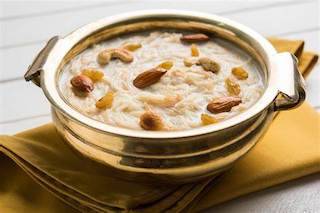
When we hear the name kheer we all think about a sweet combination of rice, vermicelli, various flavours, dry fruits etc. Kheer is a milk-based pudding consumed throughout the Indian subcontinent. Its creamy texture, aromatic fragrance and mouth watering taste makes it a unique traditional dessert. Kheer is known by different names in different regions of India namely- payasam, payesh, phirni.
As per ancient records, Kheer is first mentioned in the fourteenth century. The name Kheer is derived from the sansktrit word Ksheerika which means sweet dish made with milk. In ancient India kheer was commonly made with rice, milk, sugar or Jaggery. Traditionally, this popular milk sweet dish was served as prasadam to devotees in Hindu temples. It was common in the past to find Kheer served as dessert at various festivals.

Even in this present day and age, Kheer is the most common dish at many Indian festivals and celebrations. Diwali, Ganesh Chaturthi, Holi, Eid are just some of the festivals during which kheer is the favorite sweet dish and dessert. Kheer is also prepared to celebrate joyous occasions like the arrival of a new born, purchase of property, engagements amongst others. There are various substitutes of kheer made with daal (lentils), vermicelli, wheat, millet, tapioca, and sweet corn.
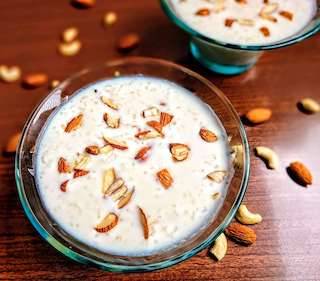
Kheer is prepared in different ways across the length and breadth of India. In Northern India, Kheer is also known as sevaiyan or semiya. In the Southern states, Kheer is a popular dessert known as payasam. Payasam is essentially made with both milk and coconut milk. If you were to offer prayers at the Guruvayur Temple or the Ambalappuzha Temple in Kerala, as prasadam, you will be served kheer or payasam that is almost divine to taste.
Through the centuries, the most common kheer recipe consisted of rice, jaggery, milk and dry fruits. But as time went on, kheer recipes began to evolve. Adding dry fruits like almonds, cashews, pistachios along with raisins, cardamom powder and saffron gives kheer a rich flavour. The use of barfi in kheer is very popular in states like Punjab, Rajashthan, Maharashtra and Gujarat. Kheer blended with barfi is a sinful combination to satisfy your taste buds. Tourists visiting India during the festival of Diwali or Eid are sure to be served kheer made with vermicelli and loaded with different kinds of barfi.

All said and done, Kheer remains an all-time perfect dessert. You don’t really need an excuse to make it. You can make anytime if feel like it; you can have it either as breakfast, an afternoon light dessert or when you crave for something sweet and delicious.
1 note
·
View note
Text
It is esteemed as the most various and a standout amongst the most prevalent cooking styles on the planet. Assorted variety in sustenance is nearly in guide extent to the decent variety in the dialect, traditions and societies in this nation. Indian dishes can be separated into four primary parts: Northern, Southern, Western and Eastern. Most Indian sustenance things have been roused by Vedic, Jain and Buddhist convictions. A few dishes were additionally presented by remote trespassers, rulers and dealers.
Indian cooking mirrors a 8,000-year history of different gatherings and societies interfacing with the subcontinent, prompting decent variety of flavors and territorial foods found in cutting edge India. Afterward, exchange with British and Portuguese impact added to the officially assorted Indian cuisine.
Antiquity
Early eating regimen in India for the most part comprised of vegetables, vegetables, natural products, grains, dairy items, and nectar. Staple nourishments eaten today incorporate an assortment of lentils (dal), entire wheat flour (aṭṭa), rice, and pearl millet (bājra), which has been developed in the Indian subcontinent since 6200 BCE.Over time, sections of the populace grasped vegetarianism amid Śramaṇa movement while an evenhanded atmosphere allowed an assortment of natural products, vegetables, and grains to be developed consistently. A sustenance grouping framework that classified any thing as saatvic, raajsic, or taamsic created in Yoga tradition.The Bhagavad Gita forbids certain dietary practices .Consumption of hamburger is forbidden, because of cows being viewed as holy in Hinduism.Beef is for the most part not eaten by Hindus in India aside from Kerala and the north east.
Medieval times to the sixteenth centuries
Amid the Middle Ages, a few Indian lines were prevalent, including the Gupta line. Making a trip to India amid this time presented new cooking techniques and items to the district, including tea. India was later attacked by tribes from Central Asian societies, which prompted the development of Mughlai food, a blend of Indian and Central Asian cooking. Trademarks incorporate seasonings, for example, saffron.
Dried beans incorporate mung beans, lentils, or chickpeas into Indian dishes, or serve them as a side (possibly in a traditional dal stew).Cardamom,An herb with medicinal properties, cardamom is used in sweets, chai tea, curries, and rice dishes.Chili peppers,Indian cuisine’s reputation for spiciness comes largely from chili peppers. The type of chili used depends on the recipe or the chef, and it can show up in paste, powder, or fresh form.Cinnamon, The sweet spice is used more commonly in savory dishes.Coriander, Both the seeds and the leaves of coriander are put to good use in Indian cooking—frequently as a spice in curries and as a garnish on dal. Cumin, A regular in Indian curries, this strong spice adds a bit of warmth and earthiness to recipes.
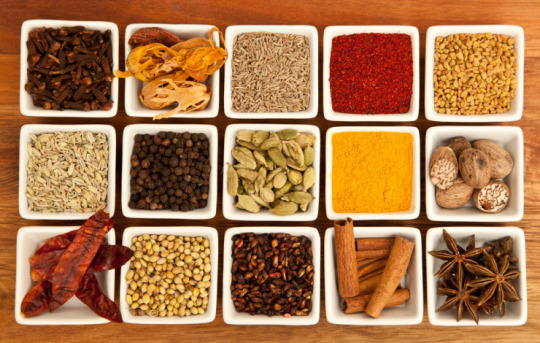
Garam masala, This blend of spices can contain everything from dried chili peppers to coriander to mustard seed to garlic. It’s typically added to a dish late in the prep so that the fragrance lingers.Ginger, An integral spice in curries, ginger is also used in vegetable dishes and adds flavor to tea and coffee drinks. To prolong the life of fresh ginger, wrap it tightly and store in the refrigerator or freezer.Mustard seed, Indian cooks use a very small, very dark version of the whole seed that has a slight smell similar to curry.Onion and garlic, Considered the “wet seasonings” of Indian cuisine, onions and garlic are used in a wide variety of dishes.Turmeric, This intensely yellow spice is used in many Indian dishes and is considered to be an antiseptic both inside and outside the body.
Variety of food in Indian cuisine
Bengali Food

Bengali cooking is refreshing for its astounding utilization of panchphoron, a term used to allude to the five fundamental flavors, in particular mustard, fenugreek seed, cumin seed, aniseed, and dark cumin seed. The claim to fame of Bengali sustenance lies in the ideal mix of sweet and hot flavors.
Gujarati Food

The customary Gujarati nourishment is principally vegan and has a high healthful esteem. The run of the mill Gujarati thali comprises of differed sorts of lip smacking dishes. Gujarati food has such a great amount to offer and each dish has a completely extraordinary cooking style.
Kashmiri Food
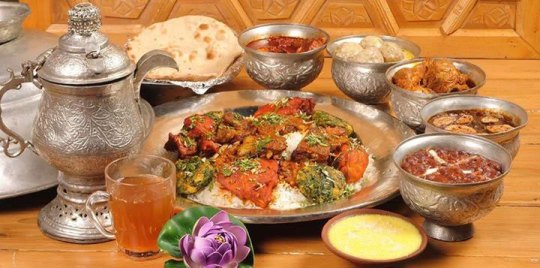
Kashmiri nourishment that we have today in the eateries has developed throughout the years. Exceedingly affected by the conventional nourishment of the Kashmiri intellectuals, it has now taken a portion of the highlights of the cooking style received in Central Asia, Persia and Afghanistan.
Mughlai Cuisine

Mughlai food is a standout amongst the most well known cooking styles, whose birthplace can be followed back to the seasons of Mughal Empire. Mughlai cooking comprises of the dishes that were set up in the kitchens of the regal Mughal Emperors. Indian food is transcendently affected by the cooking style working on amid the Mughal period.
Punjabi Food

The cooking of Punjab has a huge assortment of mouth-watering veggie lover and also non vegan dishes. The flavor content extents from insignificant to lovely to high. Punjabi nourishment is generally savored by individuals of all groups. In Punjab, home cooking contrasts from the eatery cooking style.
Rajasthani Food
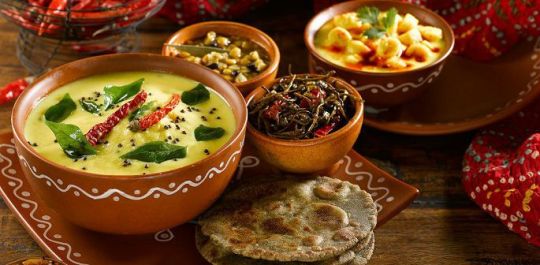
The cooking of Rajasthan is essentially vegan and offers an awesome assortment of delicious dishes. The flavor content is very high in contrast with other Indian cooking styles, yet the sustenance is totally delightful. Rajasthanis utilize ghee for cooking the greater part of the dishes. Rajasthani sustenance is notable for its fiery curries and heavenly desserts.
South Indian Cuisine

The food of South India is known for its light, low calorie tempting dishes. The customary nourishment of South India is fundamentally rice based. The cooking is well known for its awesome blending of rice and lentils to plan yummy lip smacking dosas, vadas, idlis and uttapams.
Beverages
Aam panna – made from raw mango.Ganne ka ras or sugarcane juice. Buttermilk – chhachh in North India, mor in Tamil, majjiga in Telugu, and taak in Marathi. Falooda – a cold and sweet beverage containing many ingredients, such as rose syrup, vermicelli, basil seeds, tapioca pearls, and pieces of gelatin mixed with kulfi, milk or water. Haldi doodh or hot turmeric milk. Lassi – a popular, traditional, yogurt-based drink from India. It is a blend of yogurt, water, spices and sometimes fruit. Traditional lassi (a.k.a., “salted lassi”, or simply “lassi”) is a savoury drink, sometimes flavoured with ground and roasted cumin. Sweet lassi, however, contains sugar or fruits, instead of spices. Salted mint lassi is highly favoured in Bangladesh.
Cashew apples being squashed in Chorao, Goa, to be utilized as a part of the arrangement of feni. Handia is a rice brew regularly made by the indigenous individuals in Bihar, Jharkhand, Odisha, Madhya Pradesh and Chhattisgarh. Desi daru is India’s one of least expensive plant made mixed drinks. Apo – conventional drink from Arunachal Pradesh produced using matured rice.Bangla – a mixed drink produced using starch and sold in West Bengal. There are government authorized counters to offer this drink. This is a refined nation alcohol.Bhang lassi – an inebriating drink arranged from the leaves and blossoms (buds) of the female cannabis plant, devoured as a refreshment in the Indian subcontinent.Bitchi – a refreshment devoured for the most part by Garo tribals.Chhaang or Tongba – drink from Sikkim produced using grain millet.Cholai Chuak – a drink from Tripura produced using rice, jackfruit and pineapple.Feni – mainstream in Goa. Gudamaba – a customary drink from Hyderabad blended from sugar stick. It used to be delivered from methane and different chemicals until the point when the legislature restricted it. Kaid Um – refreshment in Meghalaya, devoured generally by Khasi and Jaintia tribes.Kallu – palm wine from Kerala. Kodo ko jaanr – otherwise called chyang, arranged from finger millet. Laopani – produced using aged rice; prevalent in Assam. Lugdi – produced using rice.Mahua – produced using mahua blossoms, Central India. Mandia pej – produced using ragi powder and stale water from bubbled rice, well known in Odissa. Manri – produced using aged rice, prevalent in Mithila. Sekmai – from the province of Manipur; produced using sticky rice. Sunda Kanji – produced using maturing rice that is covered in earthen or mud pots secured with material, sold in Tamil Nadu.Flavor/Tadi/Kallu (palm wine). Zawlaidi – prominent in Mizoram arranged from rice, millet and maize. Zutho – from Nagaland
Sweets
Gulab Jamun ,The good old delight made with khoya, fried golden and finally dipped in saffron induced sugar syrup.
Gajar Ka Halwa,Warm your winter with this recipe that is sure to delight even the pickiest of dessert eaters! Halwa made Pakistani style with grated carrot, condensed milk, nuts and golden varq.
Sandesh,A melt-in-the-mouth dessert! Bengal’s super hit sweet, made with cottage cheese, cardamom and saffron. One of the easiest way to please the sweet tooth!
Modak,Sweet flour dumplings stuffed with coconut, jaggery, nutmeg and saffron. Steamed to perfection. A famous Indian dessert prepared during the festival of Ganesh Chaturthi.
Aam Shrikhand ,A Gujarati favorite made with hung curd. Few ingredients, great flavors! In this recipe mildly sweetened yogurt is studded with mango pieces and served with a zesty mango salad.
Payasam,The South Indian version of kheer is known as payasam. Deliciously creamy, rice and milk pudding with cashews and raisins.
Kaju ki Barfi,This one’s a childhood favorite with many! Barfi made with cashew nuts and milk, topped with silver varq. Usually exchanged as a sweet gift on special occasions.
Shahi Tukda,The earliest visitors to India called it the land of milk and honey. Marut Sikka whips up a rich, saffron infused shahi tudka from Awadh. The recipe of Shahi Tukda is believed to have been invented out of a way to use up unused bread in the nineteenth century Mogul cuisines.
Phirni,Another variety of a milk pudding prepared during festive occasions especially Eid and Ramzan. Best served in ‘mitti ke kasore’ or mud pots.
Kulfi,A popular frozen dessert that is sinfully rich, dense and creamy. A twist to the traditional recipe, this one is flavored with mango.
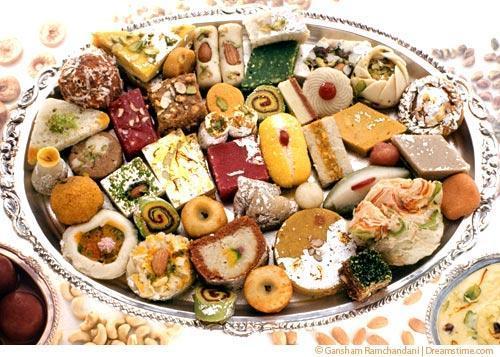
Health & Indian cuisine
Typical components of an Indian diet:
High in a wide variety of vegetables and fruit, such as spinach, aubergine and mango
High in a variety of spices and herbs, such as ginger and coriander
Low in saturated fat
Widely vegetarian
High in fibre
Chickpeas, for instance, which are regularly utilized as a part of vegan curries, are an extraordinary wellspring of fiber, zinc, folate and protein, which makes them a sound factor in a veggie lover Indian eating regimen. Spinach and tomatoes, which are generally utilized as a part of Indian food, are likewise known superfoods, containing abnormal amounts of cancer prevention agents, vitamins and minerals.
In like manner, numerous Indian sauces and backups are vegetable based, for example, Sag aloo (spinach) and Gobhi Aloo (cauliflower with potatoes) settling on them a solid decision as the greater part don’t utilize cream or cheddar.
The minty yogurt plunge raita, produced using characteristic yogurt, cucumber and mint, is a wellspring of calcium and is a low fat contrasting option to sauces, for example, mayonnaise. Characteristic yogurt is likewise frequently used to shape curry sauces rather than cream or coconut drain.
Garlic includes enormously in Indian cooking, which is said to be useful for the heart, as do chillies, which are useful for the safe framework and digestion.
Indian dishes frequently utilize vegetable, sesame and nut oil as opposed to spread, which keeps them bring down in soaked fat.
At long last, as Indian dishes have such an affecting taste regularly only a little segment can fulfill taste buds, helping you to devour less calories. An Indian eating regimen’s assortment and dynamic quality keeps it fascinating, which is a solid part to any food as assortment can avert fatigue and indulging.
“A vegetable curry with dal is a great choice in an Indian cuisine”
Indian cuisine:Unity in diversity It is esteemed as the most various and a standout amongst the most prevalent cooking styles on the planet.
0 notes
Text
Super Delicious Millets in Native Food Store
Millets are a group of small-seeded grasses that are commonly grown in semi-arid regions of Asia and Africa. They are known for their nutritional benefits and have been a staple food in many parts of the world for centuries. Millets are rich in nutrients such as fiber, protein, vitamins, and minerals. They are particularly high in iron, calcium, and magnesium. Millets are gluten-free, making them a great option for people with celiac disease or gluten intolerance. Millets are rich in antioxidants and have been shown to help reduce the risk of cardiovascular disease.
#Millet#Millet noodles#millet flakes#Millet Muesli#Millet Dosa mix#Cold pressed Oil#Rice mix Powders#Millet Vermicelli and Jaggery powder#Cold pressed Oil in chennai#Herbal Juice Archives#millet noodles indian#millet noodles#millet muesli#millet vermicelli and jaggery powder#millet dosa mix#millets traditional rice#best native food store#cold pressed oil#millets traditional rice in chennai
1 note
·
View note
Text
Millet Nutrition Products in Native Food Store
Millet is a type of grain that is widely consumed around the world. It is a rich source of nutrients and offers several health benefits. Here are some of the benefits of consuming millet. Rich in Nutrients: Millet is a good source of essential nutrients such as protein, fiber, vitamins, and minerals like iron, calcium, magnesium, and potassium. Gluten-free: Millet is naturally gluten-free, Lowers Cholesterol: Studies suggest that millet can help reduce LDL (bad) cholesterol levels in the body, which can help reduce the risk of heart disease. Regulates Blood Sugar: Millet has a low glycemic index, which means that it can help regulate blood sugar levels and reduce the risk of diabetes. Some popular millet products include millet flour, millet flakes, and millet porridge.
#millet flakes#millet noodles indian#best native food store#millet muesli#cold pressed oil#millet noodles#millet dosa mix#millet vermicelli and jaggery powder#millets traditional rice#millets traditional rice in chennai
0 notes
Text
Cold pressed oils for Natural and Nutrients | Native Food Store
Cold pressed oils are oils that are extracted from seeds, nuts or fruits using a hydraulic press or screw press, without the use of heat or chemicals. This method of extraction helps to preserve the natural nutrients, flavors, and aromas of the oil. Cold-pressed oils offer many benefits, but they are still high in calories and should be consumed in moderation as part of a balanced diet.
#millet flakes#millet noodles indian#best native food store#millet vermicelli and jaggery powder#millet noodles#millet muesli#cold pressed oil#millet dosa mix#millets traditional rice#millets traditional rice in chennai
1 note
·
View note
Text
Cold pressed oils for Natural and Nutrients | Native Food Store
Cold pressed oils are oils that are extracted from seeds, nuts or fruits using a hydraulic press or screw press, without the use of heat or chemicals. This method of extraction helps to preserve the natural nutrients, flavors, and aromas of the oil. Cold-pressed oils offer many benefits, but they are still high in calories and should be consumed in moderation as part of a balanced diet.
#millet flakes#millet noodles indian#cold pressed oil#best native food store#millet dosa mix#millet muesli#millet noodles#millet vermicelli and jaggery powder#millets traditional rice#millets traditional rice in chennai
1 note
·
View note
Text
Millet Muesli for Healthy Breakfast - Native Food Store
Millet muesli is a breakfast cereal made with millet, a small, round grain that is commonly used in African and Asian cuisine. Millet is a gluten-free grain that is high in fiber, protein, and essential vitamins and minerals. fruit juice, and can be customized to suit your taste preferences by adding your favorite fruits, nuts, and spices. It's a great option for those who are looking for a gluten-free and nutritious breakfast that is easy to prepare and can be made ahead of time.
#millet flakes#millet noodles indian#best native food store#millet dosa mix#cold pressed oil#millet muesli#millet noodles#millet vermicelli and jaggery powder#millets traditional rice#millets traditional rice in chennai
1 note
·
View note
Text
Millet Muesli for Healthy Breakfast - Native Food Store
Millet muesli is a breakfast cereal made with millet, a small, round grain that is commonly used in African and Asian cuisine. Millet is a gluten-free grain that is high in fiber, protein, and essential vitamins and minerals. fruit juice, and can be customized to suit your taste preferences by adding your favorite fruits, nuts, and spices. It's a great option for those who are looking for a gluten-free and nutritious breakfast that is easy to prepare and can be made ahead of time.
#millet flakes#millet noodles indian#best native food store#cold pressed oil#millet dosa mix#millet muesli#millet noodles#millet vermicelli and jaggery powder#millets traditional rice#millets traditional rice in chennai
1 note
·
View note
Text
Healthy Native Traditional Food Products in Chennai
Multi Millet noodles is a power packed and easy to make meal. That combines the goodness of five nutritious millets and whole wheat atta. Native Food Store Millet Noodles are very healthy and tasty noodles. Its taste is really good and having lot of healthy nutrients.
#Millet noodles#millet flakes#Millet Muesli#Millet Dosa mix#Rice mix Powders#Cold pressed Oil#Millet Vermicelli and Jaggery powder
2 notes
·
View notes
Text
Native Millets Traditional Rice in Chennai









Simply said, you use millet as you use rice. You can also roast millet into a kind of small popcorn or use it as couscous or bulgur. In India, millet is often cooked in a pressure cooker, not so much to save time, but for an extra fluffy result. Loosen the grains after cooking, a bit like with couscous, to prevent them from clumping together. The different types of millet taste about the same (a little grainy and a little bitter) and can all be prepared in the same way.
#traditional rice in chennai#millets traditional rice#millets traditional rice in chennai#millet noodles indian#millet muesli#millet noodles#millet flakes#cold pressed oil#millet dosa mix#millet vermicelli and jaggery powder#best native food store
1 note
·
View note
Text
Native Millets Traditional Rice in Chennai
Simply said, you use millet as you use rice. You can also roast millet into a kind of small popcorn or use it as couscous or bulgur. In India, millet is often cooked in a pressure cooker, not so much to save time, but for an extra fluffy result. Loosen the grains after cooking, a bit like with couscous, to prevent them from clumping together. The different types of millet taste about the same (a little grainy and a little bitter) and can all be prepared in the same way.
#traditional rice in chennai#millets traditional rice#millets traditional rice in chennai#millet noodles indian#Millet noodles#millet flakes#Millet Muesli#Millet Dosa mix#Rice mix Powders#Cold pressed Oil#Millet Vermicelli and Jaggery powder#Cold pressed Oil in chennai#Herbal Juice Archives
1 note
·
View note